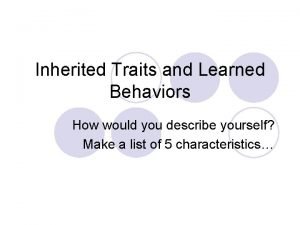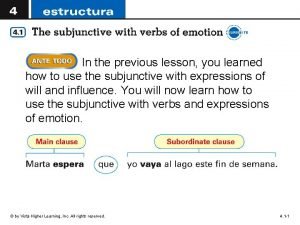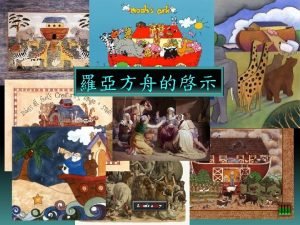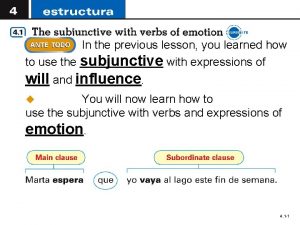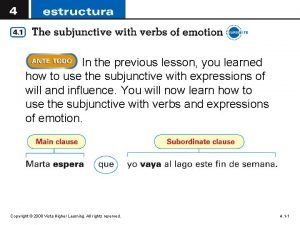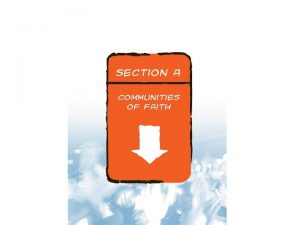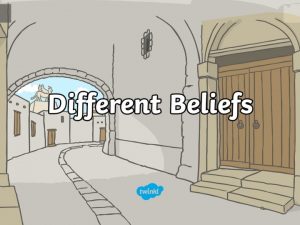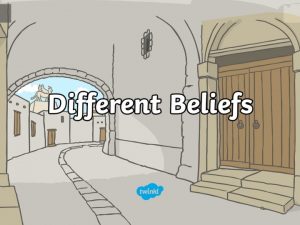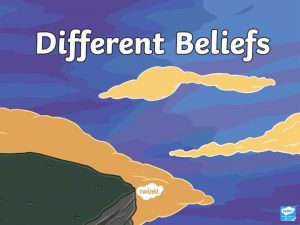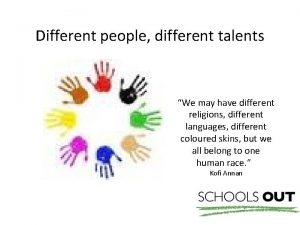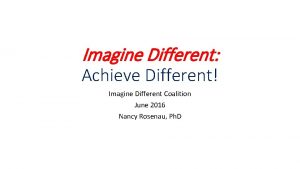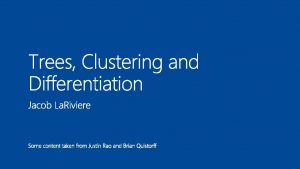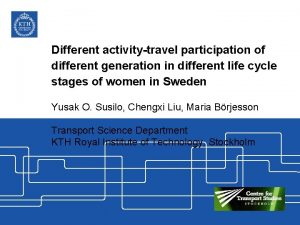What have we learned We have explored different

















- Slides: 17


What have we learned? • We have explored different types of community. Family – School – Local – Faith – Medical – Sports • We have identified common and particular characteristics of these communities. • We have explored the tension that can exist between the needs of the individual and the needs of the community. The word characteristic means a feature or quality that makes somebody or something recognisable.

We have explored the tension that can exist between the needs of the individual and the needs of the community. Weaknesses that lead to community breakdown Strengths of Community • • • Co-operation Sharing Good communication Fulfilling roles Help and support • • • Lack of co-operation Not sharing Poor communication Failure to carry out roles Failure to deal with tension between the members


What have we learned? • We can describe the role of communities in society. The communities to which we belong provide us with a service, i. e. they fulfil some of our needs. Communities enable us to grow and change and they work with us to help us achieve our goals in life. • We recognise the variety of roles within communities, including leadership roles.

Trócaire Inspiration Commitment and service Impact of this work Variety of roles • Trócaire, which means ‘compassion’ in the Irish language, draws its vision from Scripture and the social teaching of the Catholic Church. • Trócaire volunteers are committed to serving the poor and the oppressed on an ongoing basis and in times of emergency, regardless of race, gender, religion or politics. • Trócaire’s work has transformed the lives of thousands of people in developing countries. • Leadership roles e. g. chairperson, director; campaign teams e. g. Campaign managers, education officers, finance officer.

The Carmelite Order of Sisters Inspiration • The Carmelite sisters are inspired by the vision of St Teresa of Avila, a very holy person who devoted her life to God and shared her experience of God with the world through her writings. • The Carmelite sisters show their commitment to serving God and others by living within an enclosed order, spending much time in contemplative Commitment prayer for the needs of the world, and working for their local community. and Service Impact of this work Variety of roles • The prayers offered for others have a great impact on the local and global community. The sisters know this because of the many people who return to thank them. • Portress / Prioress / Bursar / Sacristan

Name of Community Inspiration Commitment and Service Impact of this work Variety of roles

We can retell stories about the founders/earliest followers of Christianity, Judaism, Islam, Hinduism and Buddhism.

Judaism Christianity Islam Hinduism Buddhism Founder/ Significant leader Abraham and Moses Jesus Christ Muhammad None Siddhartha Gautama How many years ago? 4000 2000 1500 3000 2500 Where? Israel Saudi Arabia India North-east India Earliest followers The ancient Hebrew people The Apostles and other converted people The family of Muhammad and people of Mecca The people who lived beside the Indus river A group of monks known as the Sangha Sacred text Tanakh (Torah) Bible – Old and New Testaments Qu’ran Vedas Tripitaka/ Mahayana Sutras


What have we learned? • We recognise the importance of respecting our own beliefs and the beliefs and convictions of others. ‘Tolerance is respect, acceptance and appreciation of the rich diversity (differences) in our world. It is a way of thinking and acting that shows respect for those who are different from us. ’ • We understand the implications of sectarianism, in Ireland elsewhere. ‘Sectarianism is a prejudiced opinion based on religion, which can result in conflict and the exclusion of those of a different faith community. Sectarianism occurs when people reject others because they do not share the same religious beliefs as themselves. ’ We looked at: The story of Gavin Brett Some of the conflict situations that exist Brett between faith communities around the world.

We have Explored the Ecumenical Movement. • At local level: Church Unity Week in our school • At national level: The Currach Community and the Glencree Community • At international level: The World Council of Churches We understand the meaning of inter-faith dialogue. – ‘Inter-faith dialogue is the term we use to describe different religions talking to one another. – Inter-faith (or inter-religious) dialogue is different from ecumenism because it refers to – dialogue between all of the world religions, not just the Christian churches. ’

Our examples: • At local level: Inter-faith prayer services in our school or community • At national level: Inter-faith Prayer Service for World Peace, Dublin, October 2001 • At international level: Pope John Paul II’s World Day of Prayer for Peace, Assisi, 2002


What have we learned? We have identified and explored different styles of leadership in human communities and in religious/church communities. • Authoritarian leadership is often referred to as traditional leadership. An authoritarian leader does not allow anyone else to become involved in the decision-making process. An authoritarian leader always ‘leads’ and expects others to follow. • Enabling leadership is about motivating and helping the group to make their own decisions. • Consultative leadership is where the leader listens to everyone in the group and allows their suggestions to influence his/her final decision.

We recognise the connection between leadership and authority in religious/church communities, in particular in the Christian churches. The Catholic Church The Magisterium is the teaching authority of the Catholic Church. It consists of the Pope, cardinals, archbishops and bishops, who provide a very important service to the Catholic tradition through their leadership. The Church of Ireland The General Synod is a meeting of bishops, clergy and lay people from all the dioceses in the Church of Ireland. It is used to direct the leadership and authority of the Church.
 Which phrase correctly describes the tang dynasty
Which phrase correctly describes the tang dynasty Elements of romanticism
Elements of romanticism Why do different polymers have different properties
Why do different polymers have different properties Cultural relarivism
Cultural relarivism Manufactured boards examples
Manufactured boards examples How are inherited traits different from learned behaviors
How are inherited traits different from learned behaviors Shows only my teeth like a snake bare fangs
Shows only my teeth like a snake bare fangs Previous lesson
Previous lesson Lessons from ants
Lessons from ants Keywords for cause and effect
Keywords for cause and effect You must unlearn what you have learned
You must unlearn what you have learned I already learned
I already learned What have we learnt from the story? *
What have we learnt from the story? * What are modifiers of human acts
What are modifiers of human acts In the previous lesson you have learned
In the previous lesson you have learned Osfm lesson plans
Osfm lesson plans Once upon a time son
Once upon a time son In our previous lesson i have learned about
In our previous lesson i have learned about





